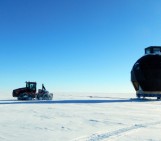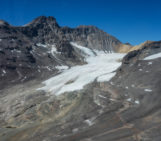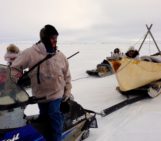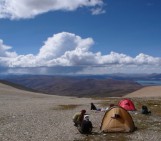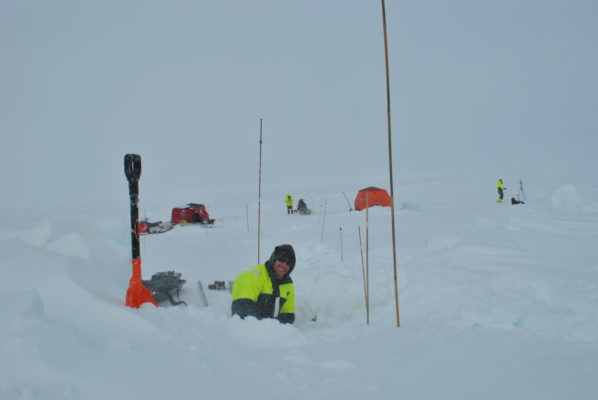
Scientist are curious people and we all know that the best discoveries happen by chance, so we always keep our eyes open for the unusual, the new, and the weird things in life. Especially, when we are out in the Arctic doing field work and find unknown brown layers…
An unexpected discovery
We were out in the Arctic, somewhere Northeast of Svalbard. It was a sunny day and we had just docked the ship to a big ice floe, which we wanted to investigate in the next days. As a standard procedure, first some sea ice scientists and the safety officer check the ice to see whether if it is safe to leave the ship. Once the ice is cleared, all other scientists rush out to set up the different sampling sites, make holes in the ice, pitch tents, and do whatever is necessary to start sampling and measuring (you can see an example in Figure 1). For the sea ice scientists, that means that they take a walk and measure different ice parameters while they do so. One of these parameters is the snow depth, for which they sometimes dig a bit in the snow (just kidding, a lot!). While digging, the team discovered something strange: in the middle of the snow, there was a brown layer. Such brown layers are well known from under the ice, where single cell algae grow in large numbers and produce brown layers (Figure 2). So the ice scientists went back on board and looked for the algae specialists to report. While they got into their regatta suits, they curiously discussed if this could be a snow algae or that maybe seawater splashed into the snow and a marine algae could have grown there. Or was it an old melt pond (a puddle on melting ice)? Many questions and only one way to find out: they had to go and look themselves. Just half an hour later, the team came back with some samples of the curious brown snow and started to investigate it. In order to find out what algae it were, they looked through a microscope. Was it one of the typical diatoms (little algae living in glass shells, very common in marine systems)? Or was it some kind of flagellate (little algae that swim around using their “tail”, also very common)?
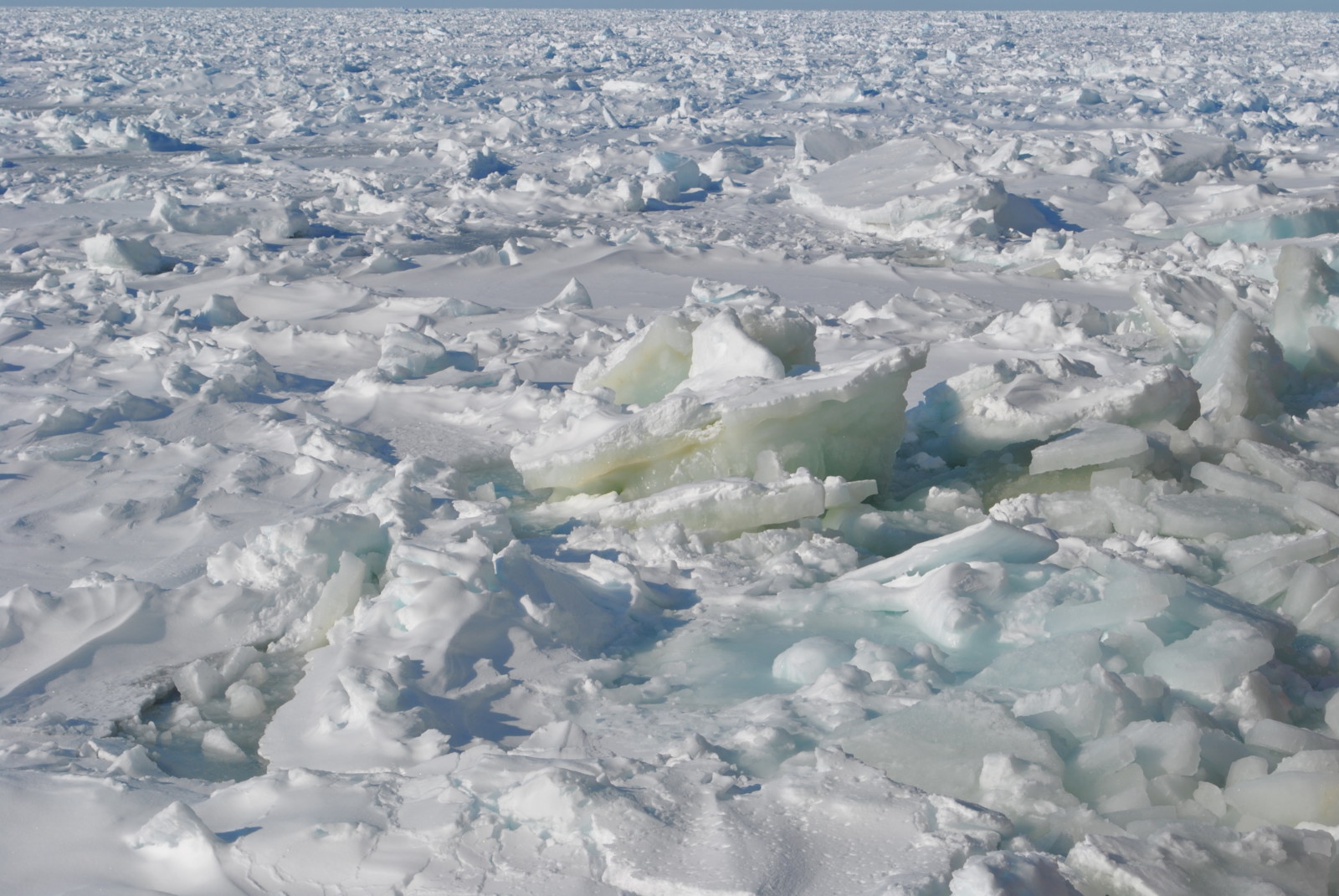
Figure 2: Ice breaking while the ship is going through it, revealing patches of sea ice algae (the brown stuff) under, but sometimes even in the ice or the snow on the Arctic Ocean [Credit: Stefan Thiele]
The mysterious snow
And so my two colleagues started their detective work to solve the mystery of the brown snow. I had still been drinking a cup of tea, but when another colleague told me the story I became very curious as well and went to see for myself; tea could wait for a while! I found one of my colleagues at the microscope, looking rather puzzled. Upon my question, what he found and what organism was growing in the snow, he shook his head, shrugged, and said he wasn’t sure. They were no diatoms, which are usually very easy to find, because their houses are very characteristic. But, they also were not flagellates, which usually move around in samples . It was some weird material and he wasn’t sure what it was. Although not an algae specialist, I offered him to take a look and see if it might be some other sort of microorganism that I might know by chance. But it did not look like anything that I had ever seen before: I saw a few bacteria, very small cells that also sometimes roam around, but far too few to explain the brown color. I also saw some more stringy things, but nothing that looked familiar or identifiable to me. So I gave up, as did my colleague, and he decided that the mystery of the snow could not be solved on board. He prepared some samples to take home and continue puzzling at home using some more advanced techniques. But this was not the end of it…
Don’t eat brown snow
Two days later, one of the crewmembers of the ship was walking around with her camera, showing everybody on board a picture that she had just taken. This made all the people very happy, so I became curious about the picture. After she showed me the small display of the camera, I joined the people in their laughter and still a smile comes to my face whenever I think about this moment. The picture revealed the answer to the mystery and confirmed that you should not eat brown snow (Figure 3). It also shows that sometimes the solution to scientific questions is simpler than you think!
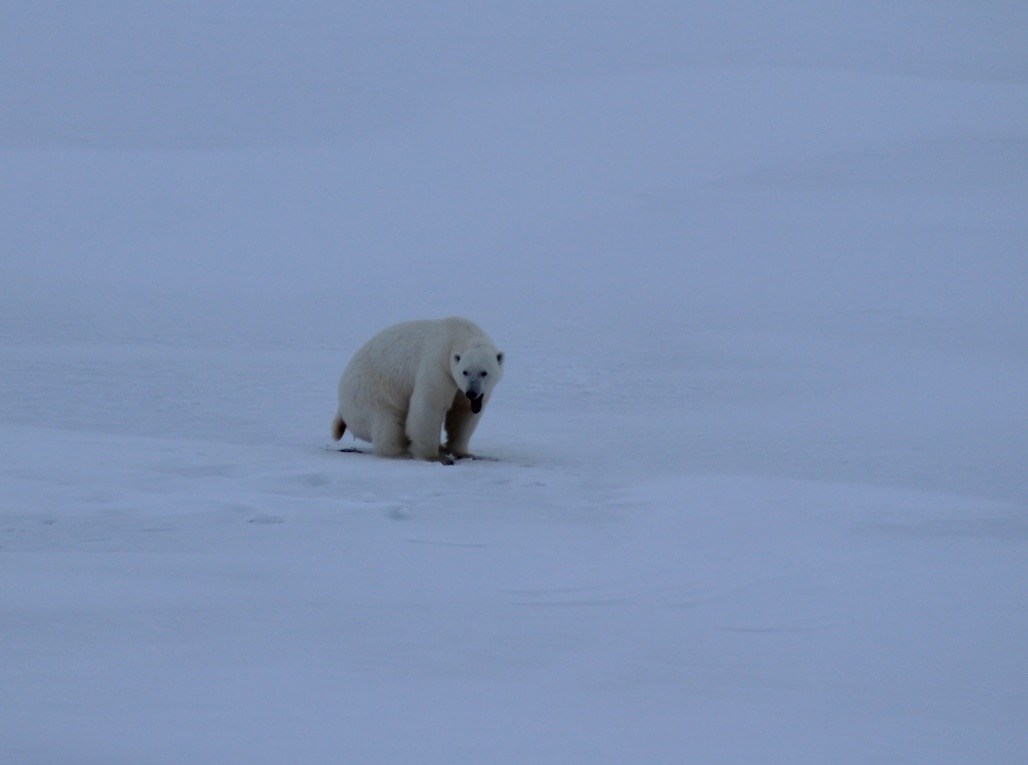
Figue3: Polar bear doing number two and creating a lot of confusion for scientists. [credit: Silje Skotnes Wollberg]
Edited by Loeka Jongejans and Giovanni Baccolo
 Stefan “Zwiebel” Thiele is a postdoc at the University of Bergen, Norway. He investigates bacterial and archaeal communities in Arctic environments such as sea ice, the marine pelagic environment or pingos in Svalbard. In addition to the polar work, Stefan also works on smaller projects regarding other bacterial and archaeal communities, e.g. in cave sediments in the Bahamas. In his free time, he conducts a second master of science in Environmental Science, where he works with microplastic in the ocean. Contact Email: stefan.thiele@uib.no
Stefan “Zwiebel” Thiele is a postdoc at the University of Bergen, Norway. He investigates bacterial and archaeal communities in Arctic environments such as sea ice, the marine pelagic environment or pingos in Svalbard. In addition to the polar work, Stefan also works on smaller projects regarding other bacterial and archaeal communities, e.g. in cave sediments in the Bahamas. In his free time, he conducts a second master of science in Environmental Science, where he works with microplastic in the ocean. Contact Email: stefan.thiele@uib.no

